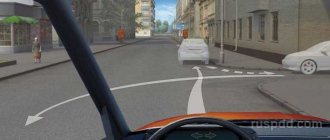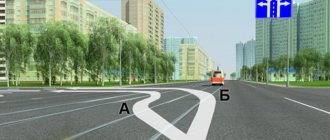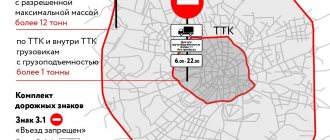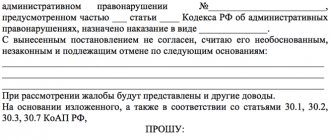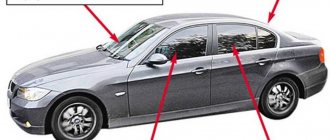Basic Concepts
The rules of the road clearly define concepts that are similar in everyday perception and do not at first glance have a significant difference.
These include:
- Overtaking is a temporary change of lane to the line of oncoming traffic with an increase in speed, in order to bypass the vehicle in front and then return to your path on a two-way highway.
- Advancement is a change in traffic lane for the purpose of overtaking, but without entering the oncoming lane.
- Changing lanes is a change in the trajectory of movement, that is, a transition from one path to another, but not accompanied by driving onto an oncoming road and not always associated with overtaking other cars.
Despite the obvious similarity of the concepts, it is worth noting that, unlike changing lanes and getting ahead, overtaking maneuvers are allowed only if certain conditions are met. Each maneuver must be accompanied by light and sound signals informing about the driver’s actions.
When driving, it is important not only to correctly interpret the content of road signs and markings, but also to classify your actions. This will allow you to avoid unpleasant sanctions and accidents due to negligence.
Leading on the right within one lane
When entering the road from the adjacent territory, the driver must give way to vehicles and pedestrians moving along it, and when leaving the road - to pedestrians and cyclists whose path he crosses *(62).
When changing lanes, the driver must give way to vehicles moving in the same direction without changing direction. When simultaneously changing lanes of vehicles moving in the same direction, the driver must give way to the vehicle on the right *(63).
Types of advance
Advancement is a more general concept than overtaking, since its main types include:
- Accelerating without changing lanes, which will actually be recognized as advancing, since the adjacent vehicle that was previously in front or to the side will be behind.
- Passing a vehicle in the left lane as a result of changing lanes from the extreme or middle lane.
- Overtaking associated with entering the oncoming line.
The list of acceptable types of lane changes is based on the fact that even at high speed limits there is no danger for road users.
The distinction between the concepts of overtaking and advancing occurred in 2010; before that, they actually meant the same thing. It is important for modern car enthusiasts to know not only the difference in terminology, but also how to behave.
Advances and detours
Overtaking is a type of maneuver in which the driver adjusts his vehicle to then overtake another without entering the oncoming lane. Overtaking is an easy maneuver that does not pose such a vital danger as overtaking. Changing lanes is carried out in a lane of passing traffic with more than one lane for traffic, respectively.
You cannot advance in areas such as a pedestrian zone, a railway crossing, or a bridge. Moreover, in all cases you need to make sure that the review is sufficient.
There are two types of advance:
- without changing lanes when the car overtakes other vehicles at its speed;
- with entry into the adjacent lane, which is not the oncoming lane.
Detour is a maneuver in which a vehicle leaves its lane if movement in the previous lane is impossible.
A maneuver is called a detour if a car changes lanes because the lane is blocked for further traffic. In other cases, maneuvers are regarded as overtaking or ahead.
Overtaking procedure
Overtaking is one of the most dangerous maneuvers that drivers make on the highway.
The fact is that at the moment of performing an action they become dependent on the actions of machines from both directions. Maximum concentration and concentration on the process is required so that everything goes smoothly and does not cause the need for other drivers to make emergency braking or turn. The main recommendations when overtaking include:
- turn on the turn signal to warn nearby vehicles that they are planning a maneuver;
- activate a more powerful gear so that the car can perform the manipulation;
- check whether overtaking will not interfere with other participants, for example, if the driver behind has already begun to make a maneuver, then you should let him pass;
- estimate the distance to cars driving in the oncoming lane in order to determine the temporary opportunity to complete the changeover into your lane.
You should not attempt to overtake on a hill, as visibility of oncoming traffic is limited. Also, in bad weather conditions there is a risk of not noticing other vehicles.
It is not recommended to overtake on narrow two-lane and mountain roads. In areas where it is difficult for two directions to pass each other, three cars driving at the same time will lead to a serious accident.
Leading on the right within one lane
At the same time, I encounter a situation where a car coming from behind passes me on the right, squeezing me towards the center of the road. After overtaking (overtaking?) they simply drive ahead of me. The purpose of such overtaking is unclear (well, actually it is clear, but we won’t talk about that).
I had already come to terms with such situations, if not for the incident yesterday. I drove through the railway crossing, pressing as closely as possible to the median, while being in my lane. There's a truck coming towards us. The width of the crossing is very narrow, just enough to allow a truck to pass with a small margin.
We recommend reading: Check your police clearance certificate by number
Leading on the right
Based on the definitions of the terms, overtaking and advancing, it follows that in Russia, with established left-hand traffic, such overtaking on the right does not exist, since this does not physically involve entering the oncoming lane. Such a maneuver will be considered ahead of the curve. There are no restrictions on changing lanes for the purpose of passing on the right in the traffic rules, but this does not mean that what is not prohibited is permitted. Overtaking on the right side of the road is not allowed, as this is contrary to other rules.
The norm for advance on the right is not highlighted separately due to the fact that the action taken will be associated with other violations.
These include:
- driving to the side of the road in order to get ahead of a vehicle traveling in the right lane;
- the vehicle speed in the right lane does not exceed the middle lane speed.
If a driver moves from the left or middle lane to the right, which is moving faster, then this will be considered a lane change. Changing lanes from the left lane will also be considered ahead if cars plan to make a turn there.
As for driving onto tram rails, this is prohibited, especially if it is associated with an attempt to overtake.
The traffic rules stipulate two situations in which this maneuver is permissible:
- Avoiding stopped vehicles that block traffic in an emergency.
- Driving during periods of increased traffic flow.
In both options, the driver must first make sure that his action will not interfere with the movement of the tram, since he has priority on the section of the road where the rails are located. Driving into the path of an oncoming tram is strictly punishable by law, as it constitutes several offenses at once: moving on the rails and in the oncoming lane.
An attempt to avoid a traffic jam on the highway on the side of the road is classified as a violation, moreover, such behavior leads to damage to the vehicle and will cause problems when changing lanes to the main lane.
The main types of overtaking and advancing
At the moment, there are two main types of vehicle advance, each of which is permitted by traffic rules:
- Getting ahead of a car without changing lanes . In this case, the vehicle is ahead of the other due to its higher speed.
- There is also advance with departure to another lane . If the movement is made on the left side, the advance, which involves overtaking, will be carried out by driving into oncoming traffic. If you are driving in the middle lane, overtaking is permissible in the left lane.
In the current traffic rules, there are a number of other indirect requirements that do not provide the opportunity to overtake on the right . The exception here is turns and junctions to the left, on the basis of which a car traveling on the left has to move.
If the movement is on the right side, if there is a desire to overtake a vehicle on the right side, the driver will need to first drive to the side of the road, which is strictly prohibited by traffic rules.
If you are driving in the middle lane and if you want to overtake a car on the right side, it will be able to move in the right lane at a speed that does not exceed the speed of the car driving in the middle lane.
Based on this, we can conclude that this manipulation will violate another clause of the traffic rules, because the legislator did not provide for separate clauses of responsibility for overtaking on the right.
Despite the absence of specific rules for overtaking on the right side, doing so is strictly prohibited . These are the most dangerous maneuvers on the road that can lead to accidents!
Sanctions
After defining the concept of overtaking on the right, let’s figure out what the fine is for the offense. As mentioned above, there is no violation of overtaking on the right and issuing a fine with this wording is illegal.
As a rule, the driver is punished for other administrative offenses:
- driving to the side of the road or sidewalk - one and a half thousand rubles;
- attempt to overtake in prohibited zones – five thousand rubles;
- driving on tram rails without objective circumstances – five thousand rubles or deprivation of a driver’s license for up to six months.
The degree of punishment is determined by how dangerous the situation became during the driver’s maneuver.
Overtaking on the side of the road involves a fine if it is proven that the purpose of changing lanes was to detour. Penalties are not imposed if, when leaving, the driver parked the vehicle and turned on the emergency stop signals. Also, traffic participants whose actions were caused by a difficult situation on the road will not be punished, for example:
- damage to the canvas, movement along which will aggravate the situation;
- Accidents in which part of the road is blocked.
If the road is narrow, then a partial drive to the side of the road is acceptable when driving towards a large vehicle.
Not only traffic police officers, but also CCTV cameras have the right to record an offense. Most fines today are based on video recordings.
When is overtaking on the right allowed?
Clause 10.4 of the traffic rules regulates the driver’s obligation outside the NP to move only to the far right. The left lane is allowed only when overtaking is necessary. This rule is canceled only within the boundaries of a city or other NP.
It is worth pointing out that overtaking the right is not allowed, but ahead is allowed. However, such a maneuver can only be performed using the vehicle lane. Overtaking on the side of the road is prohibited in accordance with paragraph 9.9 of the Rules.
Only cyclists and moped owners can move along the side of the road. Moreover, cyclists must be at least 14 years old. Also, if there are special paths, these road users cannot use the side of the road.
If the road has only two lanes and is highly congested, the driver should not change lanes. You need to move in the general flow until the lane is free.
It would be a good idea to remind you about the safety of overtaking on the right in adverse weather conditions. When the road surface is wet or foggy, it is better to slow down and be extra vigilant.
Who has the right to overtake on the right?
The traffic rules clearly state that there is no violation of overtaking on the right as such, however, this maneuver is directly related to entering a prohibited area: the roadside and sidewalk.
Punishment is imposed under two articles:
- performing a maneuver contrary to the law;
- driving in a prohibited area.
The exception to the rule is cyclists. They are full participants in the road traffic and are required to comply with the rules and regulations. If the road does not have a dedicated lane for them, then cyclists have the right to ride on the side of the road. This presumption applies to persons over fourteen years of age.
All devices equipped with more powerful engines, including motorcycles, are treated like cars. They are equally influenced by the surface, weather conditions and conditions on the track.
Rules for overtaking on the right
The rules for overtaking state that it is often carried out on the right side on sidewalks or roadsides. If we talk about in what cases it is prohibited, then it can be noted that the prohibition is enshrined in clause 9.9 of the traffic rules. If in this case the driver comes to the attention of the traffic police inspector, then a fine will be applied to him. In this case, the penalty is applied for committing two violations at the same time - this is performing a maneuver that is prohibited, as well as driving on the side of the road.
In this case, the relief does not apply to persons who drive mopeds and bicycles. They can drive vehicles along the side of the road when there are no designated paths for this purpose.
Leading on the right within one lane
11.4. Upon completion of overtaking (except for permitted overtaking on the right side), the driver must return to the previously occupied lane. However, with two or more lanes for traffic in a given direction, the overtaking driver may, taking into account paragraph 9.4 of the Rules, remain in the left lane if, upon returning to the previously occupied lane, he would have to immediately begin a new overtaking, and if he does not interfere with vehicles moving behind him at a higher speed.
In populated areas, taking into account the requirements of this paragraph and paragraphs 9.5, 16.1 and 24.2 of the Rules, vehicle drivers can use the lane that is most convenient for them. In heavy traffic, when all lanes are occupied, changing lanes is only allowed to turn left or right, make a U-turn, stop, or avoid an obstacle.
What it is
Dear readers! The article talks about typical ways to resolve legal issues, but each case is individual. If you want to find out how to solve your particular problem , contact a consultant:
+7 (499) 938-81-90 (Moscow)
+7 (812) 467-32-77 (Saint Petersburg)
8 (800) 301-79-36 (Regions)
APPLICATIONS AND CALLS ARE ACCEPTED 24/7 and 7 days a week.
It's fast and FREE !
Overtaking is one of the types of advance. When performing it, the vehicle always enters the oncoming lane at a speed greater than the speed of the car in front and returns back to the part of the road it previously occupied.
Advancement - driving without entering another lane and exceeding the speed in relation to vehicles moving in the adjacent lane; or entering an adjacent lane without subsequently returning to your own.
There are two types of advance allowed by the rules:
- No lane change. Advancement occurs due to an increase in speed.
- With exit to the next lane. It can be done from the left and right lanes, without entering the oncoming lane.
According to the law, overtaking and ahead are different concepts. The first is possible only on the left, and the second on both the left and the right.
There is another common term - changing lanes, which should not be confused with overtaking and getting ahead. This is leaving your own lane or row while fixing the original direction. Changing lanes can also be done at any time, as an advance.
In the picture, the yellow car is ahead of the curve, and the green car is changing lanes:
Overtaking is not:
- ahead of transport without crossing markings;
- ahead on the right side of the road without entering the oncoming lane.
It is relevant when the roadway consists of two lanes, one in each direction. If there are more of them, it would be better to advance without driving into the oncoming traffic. It's more secure.
This maneuver should be performed if the traffic intensity, road conditions and vehicle capabilities allow the driver to then move at higher speeds than before, since the car in front of him was going slower.
Such an action will not always be a traffic violation. If there are no prohibiting signs or markings, it is carried out according to the rules. But in many cases it is not allowed.
Overtaking is prohibited in the following cases:
- a car moving in front of the one about to make a maneuver signals with a left turn signal that it is turning left;
- the car in front is overtaking or driving around an obstacle;
- a vehicle moving behind is overtaking;
- with prohibitory signs;
- poor visibility on the road;
- on a four-lane road;
- at a pedestrian crossing;
- on difficult sections of the road.
If it starts according to the rules, on a broken marking line, and ends on a solid line, then it will be punished as for crossing a solid line.
Overtaking is allowed:
- On a two-lane road with intermittent markings.
- Three-lane road with intermittent markings.
The faster the maneuver is completed, the safer it will be. Therefore, experts recommend increasing the speed when performing it.
Why is the phrase “overtaking on the right” controversial?
Before the amendments were made in 2010, the concept of advance did not exist in the traffic rules; by definition, the concept of overtaking was equivalent. In the old definition, unlike the current one, it is not necessary to enter the oncoming lane; it was enough to leave the occupied lane. In this regard, the phrase “overtaking on the right” was completely justified and appropriate.
But when changes were made to the traffic rules, this phrase began to cause controversy, since when overtaking it is now mandatory to enter the lane or side with oncoming traffic. And when overtaking passing vehicles on the right side, such a course of events is impossible, because entering the oncoming lane can only take place when overtaking on the left side.
In fact, when overtaking on the right, the driver enters the right free lane with passing traffic and gets ahead of the vehicle, which is moving at a lower speed than him. It follows from this that it is more appropriate to call such a maneuver forward on the right, then it will fully comply with the concepts given in current legislation and will not cause any contradictions.
